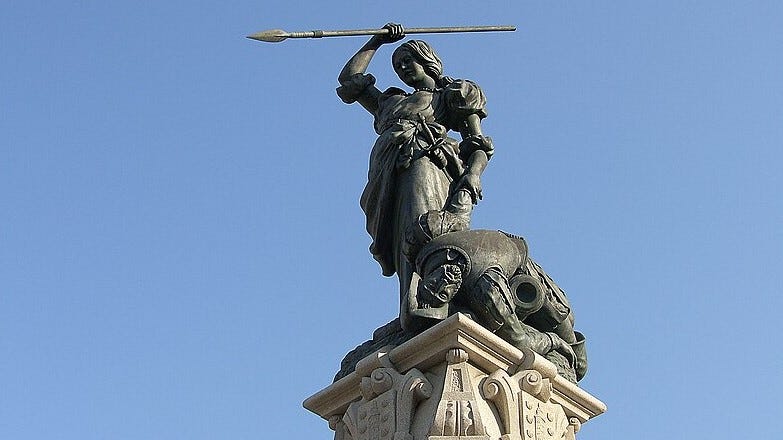María Pita Against The English Armada
A feminine archetype of civic resistance in the Renaissance

Far too common as a trope of modern action heroines, the “girlboss” or “Mary Sue” is a female character with seemingly-magical fighting prowess against much larger, clearly more powerful men. That is not what we see in this statue. Something far more interesting is happening in this scene. María Pita, the woman sporting the deflagged banner over the vanquished English ensign (guidon flag bearer) in this work of public art, was a real woman who lived in Coruña in the northwest corner of Spain. She received an infantryman’s salary from the throne as a pension in thanks for her defense of the city. Whether she really shouted Quen teña honra, que me siga ("Whoever has honour, follow me!" in Galician) or not, contemporaries did note her brave performance in the siege of Coruña, and then she spent the rest of her life inhabiting her own legend. For their own reasons, others built upon that legend long after she was gone. Her statue, a symbol of popular resistance to foreign aggression, was dedicated ten years before Spain lost the last vestiges of Philip’s empire in a brief war with the United States.
Born María Mayor Fernández de Cámara y Pita, she was about 25 years old in 1589, when the English Armada came to Galicia. Forgotten today, this English aggression was the immediate sequel to the much more famous defeat of the Spanish Armada. For “the triumph was not celebrated with fireworks” in London, Luis Gorrochategui Santos writes in The English Armada: The Greatest Naval Disaster in English History. “Instead, England set out on a substantial propaganda campaign and, together with the rest of the Protestant world, [England] was flooded with pamphlets, popular songs, poems, engravings, coins, medals and so on.” After much ballyhoo and preparation, a joint stock was raised and a fleet sailed for Galicia, only to meet with misfortunes at least the equal of the Spanish experience in the English Channel. Coruña resisted them, and María Pita became a living symbol of that civic resistance. She inhabited her own legend in her own lifetime, ensuring her personal historical legacy. María Pita was not the first woman remembered for participation in the defense of her city during the Renaissance, indeed she was able to inhabit a pre-existing cultural trope.
Keep reading with a 7-day free trial
Subscribe to Polemology Positions to keep reading this post and get 7 days of free access to the full post archives.

